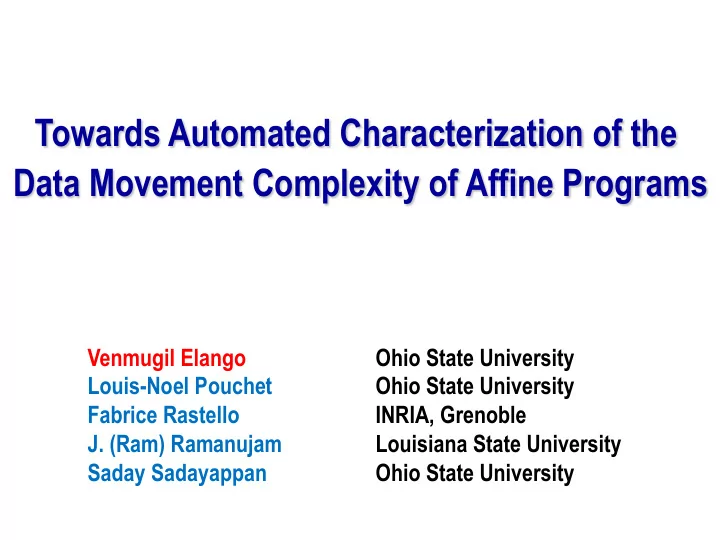

Towards Automated Characterization of the Data Movement Complexity of Affine Programs Venmugil Elango Ohio State University Louis-Noel Pouchet Ohio State University Fabrice Rastello INRIA, Grenoble J. (Ram) Ramanujam Louisiana State University Saday Sadayappan Ohio State University
Computational vs. Data Movement Complexity for(it = 1; it<N − 1; it +=B) for (i=1; i<N-1; i++) for(jt = 1; jt<N − 1; jt +=B) for (j=1;j<N-1; j++) for(i = it; i < min(it+B, N − 1); i++) A[i][j] = A[i][j-1] + A[i-1][j]; for(j = jt; j < min(jt+B, N − 1); j++) Untiled version A[i][j] = A[i − 1][j] + A[i][j − 1]; Comp. complexity: (N-1) 2 Ops Tiled Version Comp. complexity: (N-1) 2 Ops ◆ Data movement cost different for two versions ◆ Also depends on cache size Question: Can we achieve lower cache misses than this tiled version? How can we know when to stop, i.e. further improvement is not possible? Question: What is the lowest achievable data movement cost among all possible equivalent versions of the computation?
Modeling Data Movement Complexity: CDAG for (i=1; i<N-1; i++) for(it = 1; it<N − 1; it +=B) for (j=1;j<N-1; j++) for(jt = 1; jt<N − 1; jt +=B) A[i][j] = A[i][j-1] + A[i-1][j]; for(i = it; i < min(it+B, N − 1); i++) for(j = jt; j < min(jt+B, N − 1); j++) A[i][j] = A[i − 1][j] + A[i][j − 1]; CDAG for N=6 ◆ CDAG abstraction: § Vertiex = operation, edges = data dep. ◆ 2-level memory hierarchy with S fast mem locs. & infinite slow mem. locs. § To compute a vertex, predecessor vertices must hold values in fast mem. § Limited fast memory => computed values may need to be temporarily stored in slow memory and reloaded ◆ Inherent data movement complexity of CDAG: Minimal #loads+#stores among all possible valid schedules
Modeling Data Movement Complexity: CDAG for (i=1; i<N-1; i++) for(it = 1; it<N − 1; it +=B) for (j=1;j<N-1; j++) for(jt = 1; jt<N − 1; jt +=B) A[i][j] = A[i][j-1] + A[i-1][j]; for(i = it; i < min(it+B, N − 1); i++) for(j = jt; j < min(jt+B, N − 1); j++) A[i][j] = A[i − 1][j] + A[i][j − 1]; CDAG for N=6 Develop upper bounds on min-cost Minimum possible data movement cost? No known effective solution to problem Develop lower bounds on min-cost
Prior Work on Lower Bounds Modeling Geometric Inequality S-partition (Hong&Kung) Segment 1 Load 1 Load Load …... FLOP Loomis-Whitney E E j VS1 Store |E| <= |E i |*|E j | FLOP 2 3 5 7 …... Load j Segment 2 Load i E i 1 2 4 6 Load § Association between iteration space and VS2 FLOP 3 data foot-print; use geometric inequality FLOP 4 § Christ et al. (2013): Automation, based on FLOP 5 § Association between schedule and generalized geometric inequality (Holder- Store special kind of graph partition of CDAG Brascamp-Lieb) Store Segment 3 § Reason about valid 2S-partitions of FLOP 6 § (+) Automated bounds, e.g., O(N 3 /sqrt(S)) graph instead of all valid schedules Store for NxN matrix-mult § (+) Generality Load …. § (-) Restricted computational model: 1) FLOP 7 § (-) Manual CDAG-specific reasoning probs. multi-statement programs; 2) Store => challenge to automate weakness of bound: ignore deps. Load Our work: Static analysis using geometric reasoning to automate lower bounds for affine codes with CDAG model
Lower Bounds: Recent Developments 1) Alternate lower bounds approach (graph min-cut based) Theory & Models 2) Modeling vertical + horizontal data movement bounds for scalable parallel systems [SPAA ‘14] Tools Applications 1) Comparative analysis of 1) Automated lower bounds for algorithms via lower bounds arbitrary explicit CDAGs 2) Assessment of compiler 2) Automated parametric effectiveness lower bounds for affine programs 3) Algorithm/architecture co- design space exploration [HiPEAC poster; POPL ’15] [HiPEAC Paper, Session 12]
Recommend
More recommend